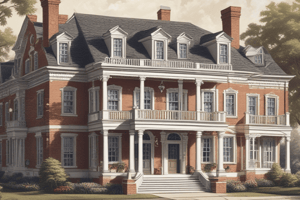Podcast
Questions and Answers
Which architectural style is characterized by symmetry, balance, and classical motifs?
Which architectural style is characterized by symmetry, balance, and classical motifs?
- Federal (correct)
- Gothic Revival
- Greek Revival
- Victorian
What era saw the rise of Italianate, Second Empire, Queen Anne, and Stick Style architecture?
What era saw the rise of Italianate, Second Empire, Queen Anne, and Stick Style architecture?
- Modernist era
- Greek Revival era
- Victorian era (correct)
- Federal era
Which architectural style is associated with modernity and luxury, characterized by geometric shapes and decorative motifs?
Which architectural style is associated with modernity and luxury, characterized by geometric shapes and decorative motifs?
- Beaux-Arts
- Modernist
- Art Deco (correct)
- Postmodernist
Who is a prominent figure in Modernist architecture, known for his organic architecture principles?
Who is a prominent figure in Modernist architecture, known for his organic architecture principles?
What style of architecture reacted against the perceived coldness and uniformity of modernism, embracing historical references and eclectic styles?
What style of architecture reacted against the perceived coldness and uniformity of modernism, embracing historical references and eclectic styles?
Which style of architecture is characterized by pointed arches, steep gables, and intricate tracery?
Which style of architecture is characterized by pointed arches, steep gables, and intricate tracery?
What era saw the rise of Federal architecture, characterized by neoclassical designs of ancient Rome and Greece?
What era saw the rise of Federal architecture, characterized by neoclassical designs of ancient Rome and Greece?
Which architectural style is characterized by columns, pediments, and symmetrical facades?
Which architectural style is characterized by columns, pediments, and symmetrical facades?
What style of architecture emphasized grandeur, symmetry, and ornamental detailing, drawing from French neoclassical traditions?
What style of architecture emphasized grandeur, symmetry, and ornamental detailing, drawing from French neoclassical traditions?
Which era saw the rise of sustainable design, adaptive reuse, and digital fabrication in American architecture?
Which era saw the rise of sustainable design, adaptive reuse, and digital fabrication in American architecture?
Flashcards are hidden until you start studying
Study Notes
Colonial Era (1600s-1700s)
- American architecture was heavily influenced by European styles, particularly English, Dutch, and Spanish.
- Buildings were simple, practical, and adapted to local climate and materials.
- Examples of styles include Cape Cod, Georgian, and Dutch Colonial.
Federal Era (Late 18th to Early 19th Century)
- Federal architecture drew inspiration from neoclassical designs of ancient Rome and Greece.
- Characteristics include symmetry, balance, proportions, and classical motifs.
- Examples of landmarks include Independence Hall in Philadelphia.
Greek Revival Architecture (Early to Mid 19th Century)
- Inspired by democratic ideals of ancient Greece.
- Features include columns, pediments, and symmetrical facades.
- Examples of government buildings include the US Capital in Washington DC.
Gothic Revival Architecture (Mid 19th Century)
- Characterized by pointed arches, steep gables, and intricate tracery.
- Examples of buildings include Trinity Church in New York City and the Smithsonian Institution in Washington DC.
Victorian Era (Mid 19th Century)
- Diverse architectural styles, including Italianate, Second Empire, Queen Anne, and Stick Style.
- Buildings boasted ornate detailing, vibrant colors, and asymmetrical designs.
- Examples of Victorian buildings reflected the eclectic taste of the time.
Beaux-Arts Architecture (Late 19th to Early 20th Century)
- Drew from French neoclassical traditions.
- Emphasized grandeur, symmetry, and ornamental detailing.
- Examples of public buildings include Grand Central Terminal in New York City and the Library of Congress in Washington DC.
Art Deco (1920s and 1930s)
- Characterized by geometric shapes, streamlined forms, and decorative motifs.
- Associated with modernity and luxury.
- Influenced the design of skyscrapers, theaters, and hotels, including the Chrysler Building and the Empire State Building in New York City.
Modernism (Mid 20th Century)
- Modernist architects sought to break away from historical styles.
- Emphasized functionalism, simplicity, and the use of new materials such as steel and glass.
- Examples of modernist designs include Frank Lloyd Wright's organic architecture principles.
Postmodernism (Late 20th Century)
- Reacted against the perceived coldness and uniformity of modernism.
- Embraced historical references, eclectic styles, and playful forms.
- Examples of postmodern buildings include Philip Johnson's AT&T Building and Michael Graves's Portland Building in Oregon.
Contemporary Architecture (21st Century)
- Encompasses a diverse range of styles and approaches.
- Examples of contemporary projects include the Highline in New York City and the National Museum of African American History and Culture in Washington DC.
- Features sustainable design, adaptive reuse, digital fabrication, and parametricism.
Studying That Suits You
Use AI to generate personalized quizzes and flashcards to suit your learning preferences.




